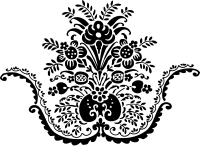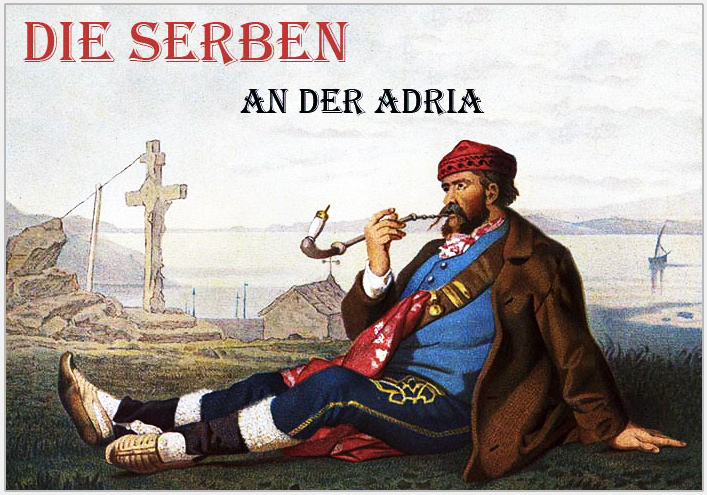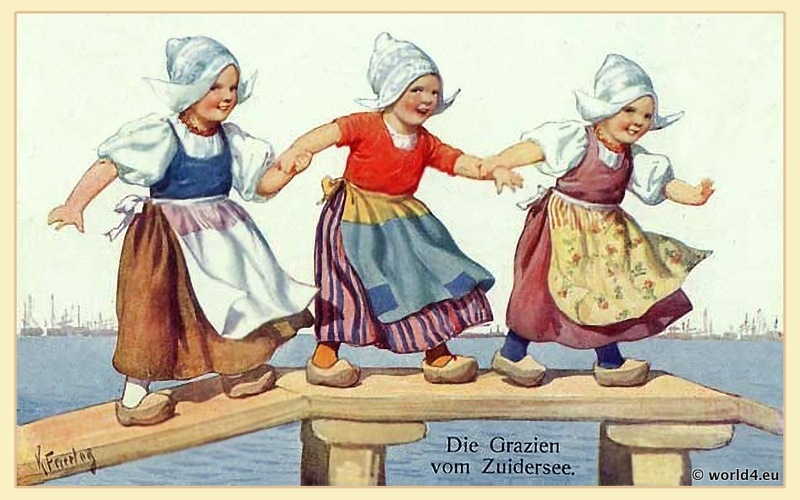Collection of costumes and type images of Serbs in the region on the Adriatic between Rijeka and northern Albania.
45 plates with color lithographs based on water colors by Ludwig Salvator.
Creators: Ludwig Salvator *, Peter Maixner, Emil Lauffer and Guido Manes (Kvido Mánes).
Published by Brockhaus Leipzig Germany.
First published by Heinrich Mercy, Prag 1870-1878.
The Serbs in the Adriatic. Their types and costumes, 1870-1878.
These illustrations are all based on watercolour paintings made on the spot by the author and executed under his direction by the painters Emil Lauffer, Guido Manes and Peter Maixner. They all depict portraits and fulfil the double purpose of serving as pictures of traditional costumes and types at the same time. In addition, most of them also show the landscape character of the respective regions in the background.
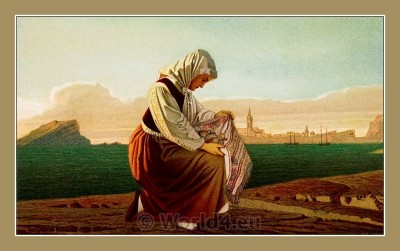







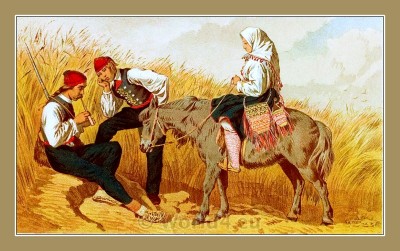

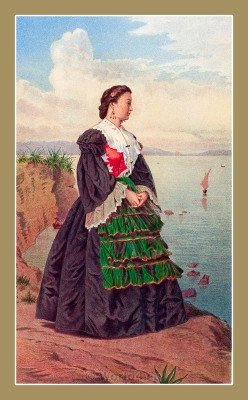

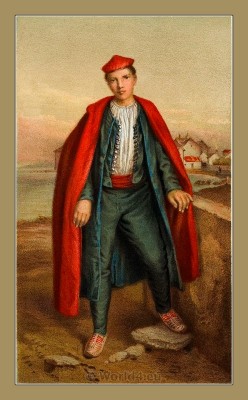


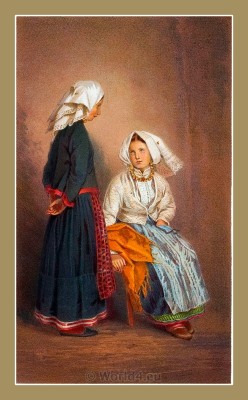
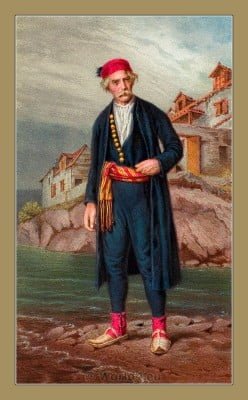



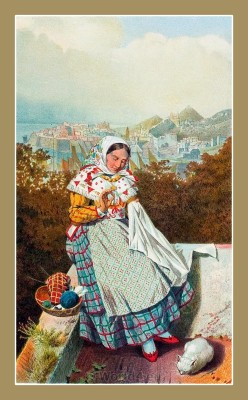




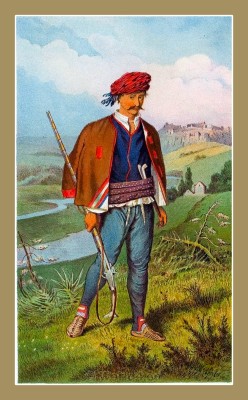


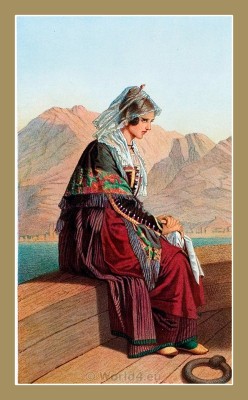


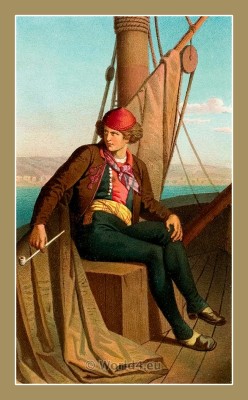
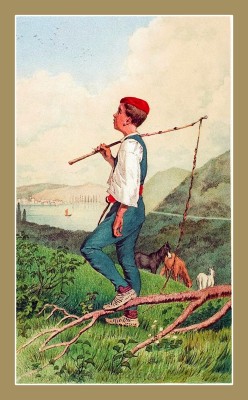
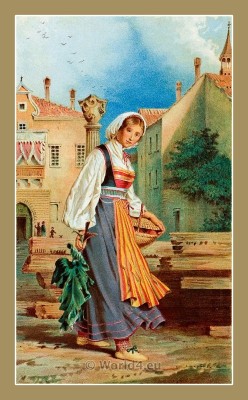


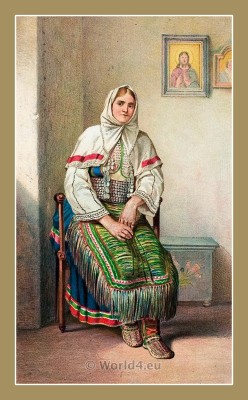
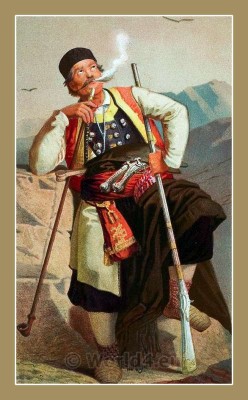
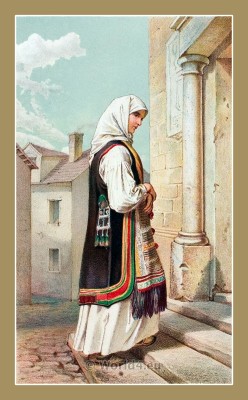



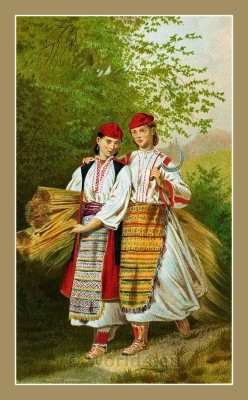

The Serbs in the Adriatic. Their types and costumes.
The 45 drawings that have appeared show almost equal numbers of men’s and women’s costumes.
The men’s clothing, in which the colours red and blue predominate in the most diverse combinations, are similar to each other in the most essential respects and are often reminiscent of the costumes of the Muslims.
The garments are mostly close-fitting, but the wide Turkish bloomers are also frequently represented; jacket, waistcoat, leggings are richly decorated with embroidery and sewn-on metal buttons. The headgear is a fez or a turban-like twisted scarf.
The women’s costumes offer us a much more varied and peculiar sight.
Many of them have a distinctly Slavic character; if we look at the women’s costumes from Pago, Budino St. Eifemia, we are vividly reminded of the folk costumes in Bohemia; the women in Vertica and Zengg in their white, embroidered with red, or even dark sleeveless outer garments, a kind of caftan, remind us of Little Russia; the peculiar headgear of the Sinians resembles partly the Russian kakoshnik, partly the cylindrical hat of the Russian nuns.
The peculiar, broad, richly fringed aprons, which also belong to the Romanian folk costume, are quite peculiar and common to almost all of them; they lend the whole a special, picturesque charm.
A wealth of jewellery of all kinds, especially the large earrings modelled on antiquity, which were also mentioned by the Archduke during his visit to the Gulf of Buccari, is a feature of all the traditional costumes we have seen.
Authors:
Ludwig Salvator, Archduke of Austria (1847-1915), Prince of Tuscany. Today he is best known for his scientific studies and regional studies in the Mediterranean region. More information at The Ludwig Salvator Society.
Emil Johann Lauffer (1837-1909) was a Moravian painter, professor and director of the Academy of Fine Arts, Prague.
Guido Manes (1829-1880), painter, born in Prague. He was in the field of genre painting, one of the leading Czech painter. He represented scenes from the middle class and people of Prague everyday life scenes from the Chod region in southwestern Bohemia.
The following text is taken from the biography of the travel book publisher and politician Leo Woerl (1843-1918). His best-known publications include the writings of the Habsburg Archduke Ludwig Salvator of Austria-Tuscany.
For the ethnologist and the archaeologist, as well as for the artist, the study of the various folk costumes of the peoples is not only of great interest, but also of scientific and artistic value.
At the same time, conclusions can be drawn from the peculiar folk costumes about their related ancestry, about the intercourse between them. They offer the painter’s brush material for charming pictures.
No people on earth can boast of possessing such beautiful costumes, distinguished by their composition of form and colour, as the South Slavs. They owe them partly to their direct contact with the Ottomans, partly to their own national genius, two elements from which a very happy combination between the opulent luxury of the Orientals and the Christian seriousness of those rough Slavic mountain dwellers has arisen.
Among the tribes of the southern Slavs, which are spread over wide stretches of land, there is none which has made itself conspicuous by a greater variety of costumes than the Serbs, who inhabit the whole coastline of the Adriatic Sea from the south of Fiume to the northern borders of Albania.
Almost every village, every mountain valley has a different type of clothing, which again shows extraordinary diversity depending on the status and age of the inhabitants.
While in most European countries the national costumes are unfortunately disappearing more and more and are at most only worn as Sunday decorations or on special festivities, especially on bridal trips, the levelling modern culture has not yet penetrated into the closed, South Slavic mountain regions, but here people still hold on to the traditional costumes with true reverence and conscientious rigour, as if to an inherited good and a delicious advantage of the homeland.
Archduke Ludwig Salvator had set himself the task of presenting a complete collection of these costumes. Unfortunately, for reasons unknown to us, the task was not fully accomplished and the work remained unfinished.
Leo Woerl was the son of geographers and cartographers Woerl Joseph Edmund (1803-1865), who was a professor at the University of Freiburg, and he was also the nephew of the owner of Herderian publishing house in Freiburg, Benjamin Herder (1818-1888 ).
Leo Woerl learned in Freiburg, Herder publishing house from 1858 to 1862 and founded the bookstore after some years of 1866 in Würzburg his own publishing house, which ranged from the theological to the literary. The publishing house was established in 1897 moved to Leipzig, then the central German city bookstores.
In 1878, the publisher began publishing of guides, one of which appeared only to the turn of the century over 600. To Woerls today known publishing activities included the publication of the writings of the Habsburg Archduke Ludwig Salvator of Austria-Tuscany, including the multi-volume edition of the work, the Balearic splendor. Woerl also wrote a 1899 published biography Ludwig Salvator. Other famous authors Woerl belonged among others Joseph Stoeckle. Leo Woerl was also politically active, he was from 1882 to 1891 worked as a councilor in Würzburg. (Source: German wikipedia)
